Effects of Various Behaviours in the Break Times between Learning
Abstract
1. Introduction
2. Related Work
3. The Behaviours in Break Times
3.1. Quiet Breaks
3.2. Active Breaks
3.3. Communication Breaks
- (1)
- Raise a flag: In this game, the user raises a red or white flag in accordance with a command spoken by RoBoHoN. The user can execute four actions: raising the red flag, dropping the red flag, raising the white flag, and dropping the white flag. These actions could be taken through the input of the keyboard connected to RoBoHoN, by assigning a corresponding key to each. For example, if RoBoHoN says “Raise a red”, the player has to press the key corresponding to raising the red flag. In the case of a correct answer, RoBoHoN moves the flag according to the spoken command, making it a visually enjoyable game.
- (2)
- Answer a riddle: The user hears the riddle told by RoBoHoN and gives the answer verbally. If the user misses the spoken riddle, they tell “please say that again” to RoBoHoN, who will say the riddle again. We had programmed five riddles, and RoBoHoN randomly chooses which one to say.
- (3)
- Guess who-I-am: The learner guessed what or who RoBoHoN was from spoken hints that it provided. RoBoHoN pretended to be an object, a person, or an animal. Upon hearing a hint (for example, “I am humanoid”), the learner made a guess. If the guess was correct, the game ended. If it was incorrect, RoBoHoN provided another hint. If the learner did not guess correctly after a certain number of hints, the game was considered over.
- (4)
- Enjoy dancing: In this behaviour, RoBoHoN danced while playing music. More than 20 dance numbers were programmed and performed randomly. If requested, RoBoHoN performed a specially designed dance form “Koi dance”.
4. Mathematical Calculation
5. Experiments
5.1. Experimental Outline
5.2. Experimental Results
5.3. Questionnaire
6. Conclusions
Author Contributions
Funding
Conflicts of Interest
References
- Merits and Demerits of Introducing E-Learning. Available online: http://www.pro-seeds.com/trend/meritdemerit.html (accessed on 13 May 2020). (In Japanese).
- Takeue, M.; Shimada, K.; Takahashi, K.; Inaba, M. Experiments of displaying images to keep the motivation in e-learning. In Proceedings of the 2012 IEEE International Conference on Systems, Man, and Cybernetics (SMC), Seoul, Korea, 14–17 October 2012; pp. 120–125. [Google Scholar]
- Ito, T.; Kotake, S.; Takahashi, K.; Inaba, M. Detecting Concentration of Students Using Kinect in E-learning. In Proceedings of the 5th IIAE International Conference on Intelligent Systems and Image Processing 2017 (ICISIP 2017), Honolulu, HI, USA, 7–12 September 2017; pp. 450–456. [Google Scholar]
- Ito, T.; Kamiya, K.; Takahashi, K.; Inaba, M. A method for identification of students’ states using Kinect. In Proceedings of the 13th International Conference on Ubiquitous Information Management and Communication (IMCOM 2019), Phuket, Thailand, 4–6 January 2019; pp. 341–350. [Google Scholar]
- Miki, T.; Terada, T.; Maeda, T.; Karasawa, H.; Adachi, J.; Tsukamoto, M. Research of the effects of the break time on work performance. IPSJ SIG Tech. Rep. 2018, 2018-UBI-57, 1–8. (In Japanese) [Google Scholar]
- Guidelines for Occupational Health Management in VDT Work. Available online: http://www.mhlw.go.jp/file/06-Seisakujouhou-11200000-Roudoukijunkyoku/0000184703.pdf (accessed on 13 May 2020). (In Japanese).
- Chong, S.; Kim, Y.J.; Lee, H.W.; Johnson, R.E.; Lin, S.-H.J. Mind your own break! The interactive effect of workday respite activities and mindfulness on employee outcomes via affective linkages. Organ. Behav. Hum. Decis. Process. 2020, 159, 64–77. [Google Scholar] [CrossRef]
- Labbé, E.; Schmidt, N.; Babin, J.; Pharr, M. Coping with stress: The effectiveness of different types of music. Appl. Psychophysiol. Biofeedback 2007, 32, 163–168. [Google Scholar] [CrossRef] [PubMed]
- Ito, T.; Takahashi, K. Experiments on Effects of Behaviours in the Rest Time between Learning. In Proceedings of the 9th Edition of the New Perspectives in Science Education Conference (NPSE 2020), Florence, Italy, 19–20 March 2020; pp. 216–221. [Google Scholar]
- Yasumura, Y.; Ito, T.; Takahashi, K.; Kajiyama, T. Effects on Concentration of Different E-Learner Resting Behaviors in Reponse to Communication Robot Actions during Break Times. In Proceedings of the 14th International Conference on Ubiquitous Information Management and Communication (IMCOM 2020), Taichung, Taiwan, 3–5 January 2020; pp. 1–5. [Google Scholar]
- Qi, P.; Gao, L.; Meng, J.; Thakor, N.; Bezerianos, A.; Sun, Y. Effects of Rest-Break on Mental Fatigue Recovery Determined by a Novel Temporal Brain Network Analysis of Dynamic Functional Connectivity. IEEE Trans. Neural Syst. Rehabil. Eng. 2019, 28, 62–71. [Google Scholar] [CrossRef] [PubMed]
- Martini, M.; Heinz, A.; Hinterholzer, J.; Martini, C.; Sachse, P. Effects of wakeful resting versus social media usage after learning on the retention of new memories. Appl. Cogn. Psychol. 2020, 34, 551–558. [Google Scholar] [CrossRef]
- Ueda, Y.; Kashiba, H.; Ishii, M.; Yanagida, T.; Kitamura, Y.; Saeki, Y. Sound effect of a music box on EEG. J. Int. Soc. Life Inf. Sci. 2000, 18, 269–275. [Google Scholar]
- Petersen, S.; Houston, S.; Qin, H.; Tague, C.; Studley, J. The utilization of robotic pets in dementia care. J. Alzheimer’s Dis. 2017, 55, 569–574. [Google Scholar] [CrossRef] [PubMed]
- Ozeki, T.; Mouri, T.; Sugiura, H.; Yano, Y.; Miyosawa, K. Use of communication robots to converse with people suffering from schizophrenia. ROBOMECH J. 2020, 7, 1–14. [Google Scholar] [CrossRef]
- Kumazaki, H.; Muramatsu, T.; Yoshikawa, Y.; Matsumoto, Y.; Ishiguro, H.; Sumiyoshi, T.; Mimura, M.; Kikuchi, M. Comedic experience with two robots aided a child with autism spectrum disorder to realize the importance of nonverbal communication. Psychiatry Clin. Neurosci. 2019, 73, 423. [Google Scholar] [CrossRef] [PubMed]
- Sharp to Release RoBoHoN Mobile Robotic Phone. Available online: http://global.sharp/corporate/news/160414.html (accessed on 13 May 2020).
- The Power of Cute: How Looking at Pictures of Baby Animals Can Help Improve Your Concentration Levels. Available online: https://www.dailymail.co.uk/news/article-2210614/The-power-cute-How-looking-pictures-baby-animals-help-improve-concentration-levels.html (accessed on 13 May 2020).
- Aibo. Available online: https://us.aibo.com/ (accessed on 13 May 2020).
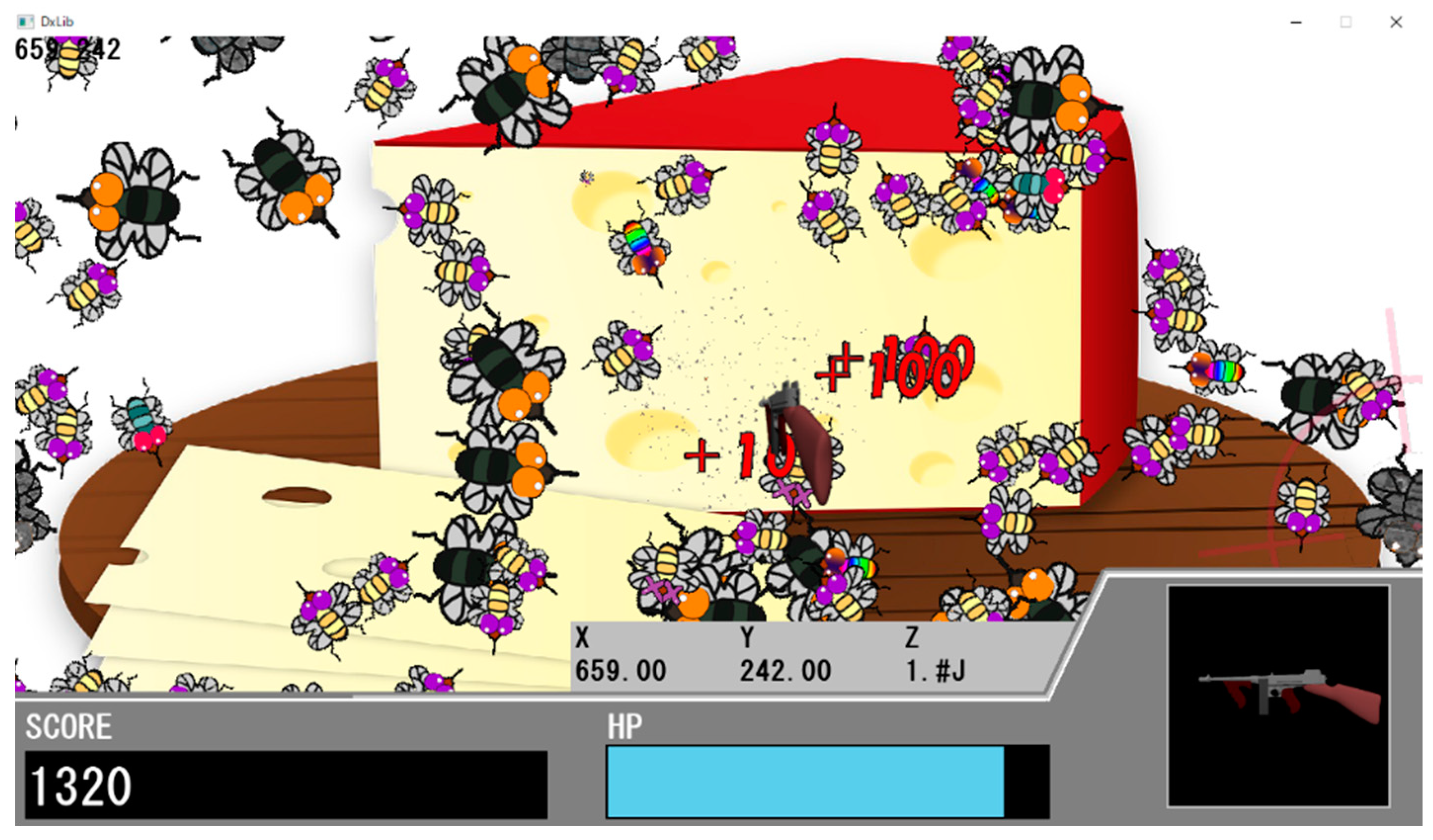
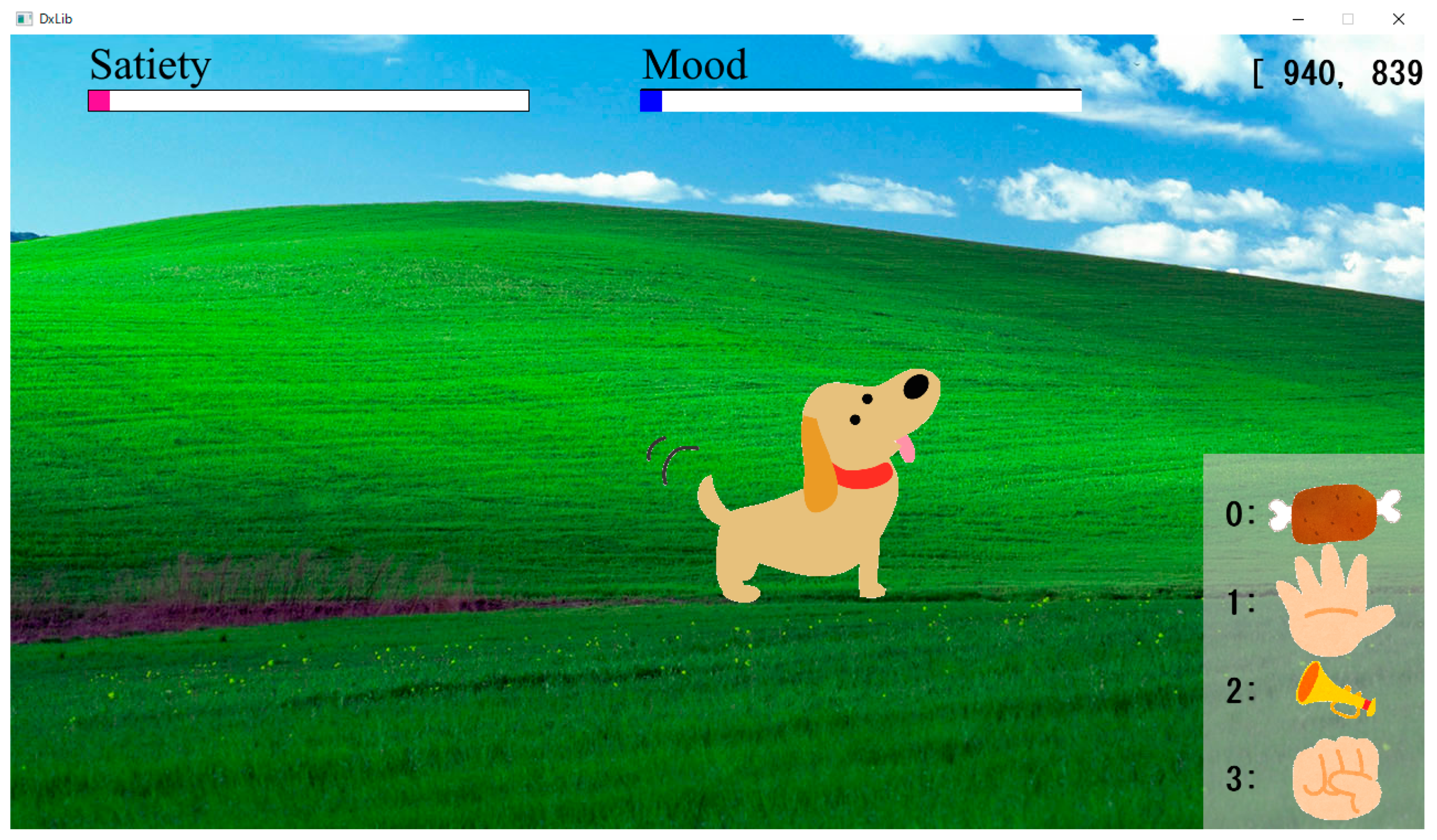
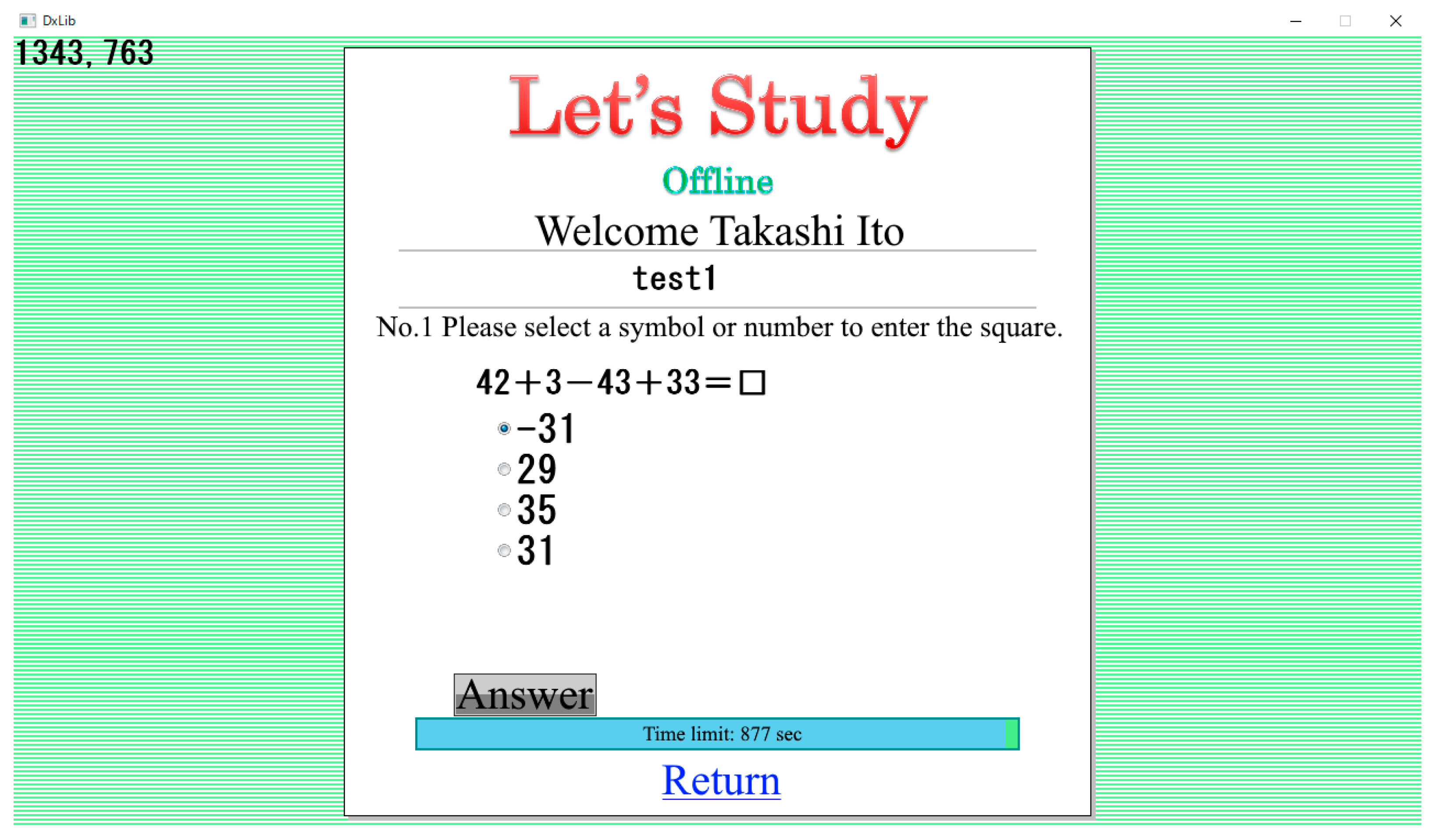

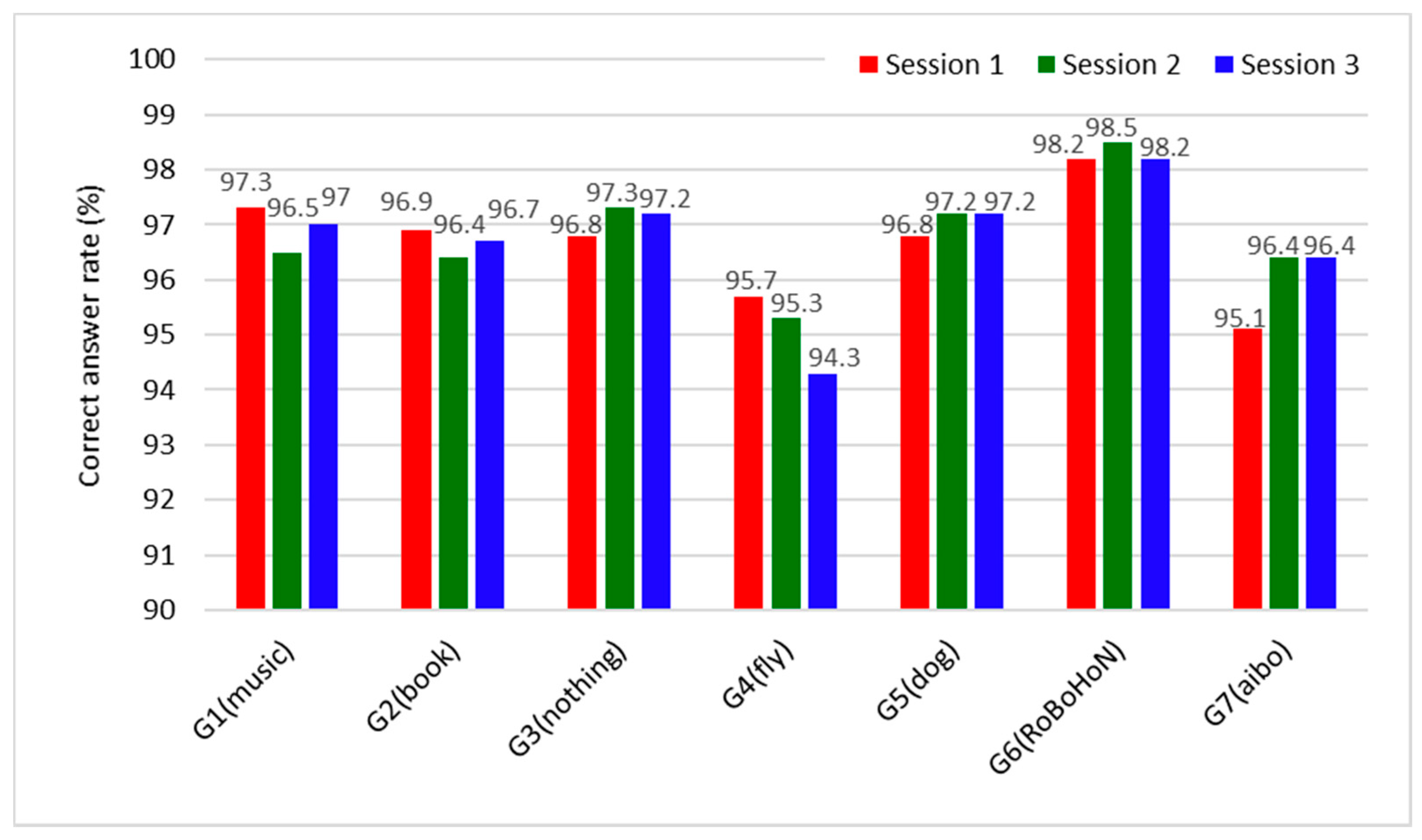
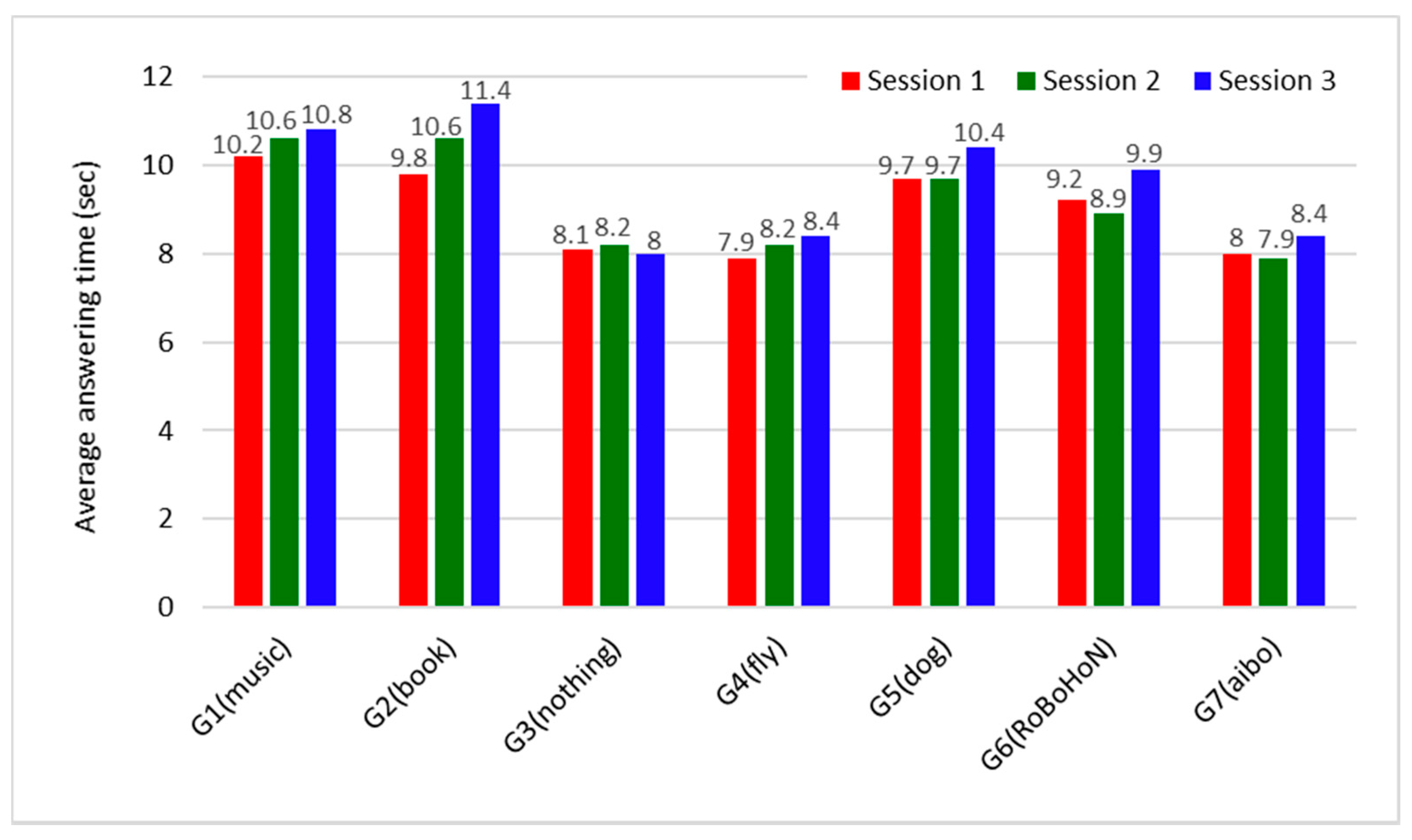
| The Contents of Behaviours | The Number of Data | |
|---|---|---|
| Group 1 (G1) | listening to music | 13 |
| Group 2 (G2) | reading a book | 12 |
| Group 3 (G3) | doing nothing | 18 |
| Group 4 (G4) | a fly-tapping game | 12 |
| Group 5 (G5) | a dog-care game | 13 |
| Group 6 (G6) | playing with RoBoHoN | 5 |
| Group 7 (G7) | playing with aibo | 5 |
| No. | Statement | G1 (Music) | G2 (Book) | G3 (Nothing) | G4 (Fly) | G5 (Dog) | G6 (RoBoHoN) | G7 (Aibo) |
|---|---|---|---|---|---|---|---|---|
| 1 | I concentrated in the 1st session. | 3.8 | 3.3 | 3.7 | 4.3 | 3.8 | 3.8 | 3.4 |
| 2 | I concentrated in the 2nd session. | 3.5 | 3.3 | 3.8 | 3.7 | 3.7 | 4.0 | 4.0 |
| 3 | I concentrated in the 3rd session. | 3.8 | 3.0 | 4.2 | 3.7 | 3.7 | 3.0 | 3.6 |
| 4 | I kept my concentration throughout the entire work. | 3.8 | 3.2 | 4.0 | 3.0 | 3.6 | 2.6 | 3.6 |
| 5 | I felt well-refreshed by the resting behaviour. | 4.5 | 3.3 | 3.5 | 3.3 | 3.7 | 4.0 | 4.0 |
| 6 | I felt that the resting behaviour improved my concentration. | 4.5 | 3.2 | 3.8 | 3.2 | 3.7 | ― | ― |
| 7 | The resting behaviour was effective. | 3.0 | 3.2 | 3.5 | 2.7 | 3.2 | 3.0 | 4.0 |
| 8 | The length of break was appropriate. | 2.5 | 3.3 | 3.9 | 3.7 | 3.4 | 2.8 | 2.6 |
© 2020 by the authors. Licensee MDPI, Basel, Switzerland. This article is an open access article distributed under the terms and conditions of the Creative Commons Attribution (CC BY) license (http://creativecommons.org/licenses/by/4.0/).
Share and Cite
Ito, T.; Takahashi, K. Effects of Various Behaviours in the Break Times between Learning. Information 2020, 11, 407. https://doi.org/10.3390/info11090407
Ito T, Takahashi K. Effects of Various Behaviours in the Break Times between Learning. Information. 2020; 11(9):407. https://doi.org/10.3390/info11090407
Chicago/Turabian StyleIto, Takashi, and Kenichi Takahashi. 2020. "Effects of Various Behaviours in the Break Times between Learning" Information 11, no. 9: 407. https://doi.org/10.3390/info11090407
APA StyleIto, T., & Takahashi, K. (2020). Effects of Various Behaviours in the Break Times between Learning. Information, 11(9), 407. https://doi.org/10.3390/info11090407




